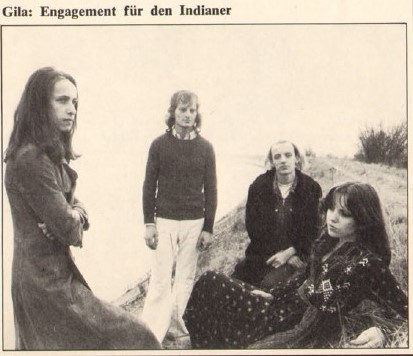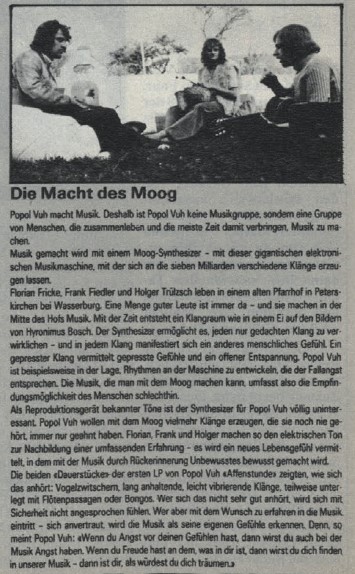The Soundtracks of Eternity
Bron: Mojo, july 2017
Auteur: A.Male
Popol Vuh - The soundtracks of eternity
Florian Fricke never had to worry about who bought his music. Born in 1944 into an independently wealthy family on the Bavarian island town of Lindau, as a teenager he studied piano at Freiburg and Munich conservatoires, a pupil of Rudolf Hindemith (brother of German composer Paul Hindemith), before dropping out to work as music and film critic for Der Spiegel, where he befriended the young New German Cinema director Werner Herzog.
Fascinated by the rituals of worship, Fricke travelled to Africa, the Middle East, India and Nepal, studying Tibetan choral music, and numerous myths and folk tales. Caught up in 1968's mood of student rebellion and spiritual revolution, Fricke bought a gigantic Moog III for 800,000 DM, and formed Popol Vuh. Named after the holy book of Guatemala's K'iche' people, and inspired by Mozart, early polyphony and the cosmic jazz of Pharaoh Sanders, Fricke's group set out to make a new kind of devotional music, eventually ditching the Moog in the belief that more 'natural' instruments - piano, oboe, harpsichords, electric guitar, and the orphic soprano of Korean singer Djong Yun - would be better suited to these non-denominational sacred sounds. From 1972 onwards Fricke recorded a series of sublime albums inspired by Christian imagery and effectively became Herzog's in-house composer, lending his films a sublime euphoria that often worked in eerie contrast to the hellish misery endured by the films' protagonists.
Yet however much the creatively free Fricke was invested in his music, he seemed to care little for its afterlife. Master tapes were lost, and certain exquisite pieces recorded for Herzog's films never appeared on record. Since Fricke died in 2001, things have got little better and the Popol Vuh catalogue is in desperate need of overhaul. With that in mind, and in the spirit of Popol Vuh, this is a guide to how things currently are, and a prayer for how they might be in the future.
10 HERZ AUS GLAS
You Say: "One of Popol Vuh's more accessible works." - Kevin Fallon, via e-mail
Subtitled Singet, denn der Gesang vertreibt die Wölfe (Sing, for song drives away the wolves), and featuring just two tracks from the Herzog film of the same name - a production where most of the actors performed under hypnosis - Herz Aus Glas is one of Fricke's finest hybrids of eastern and western sounds. The first album without Djong Yun's vocals, it's a purely instrumental affair, moving from ethereal Indian folk to soaring metal heaviosity (especially on the incredible Hüter Der Schwelle), and, at times, as on tracks like Blätter Aus Dem Buch Der Kühnheit, interweaving the two sounds perfectly, twin worlds linked by a constant ever-present unifying drone.
9 DAS HOHELIED SALOMOS
You Say: "A suitably devotional treatment of its subject." - Alex Schafer, via e-mail
A new cycle in Popol Vuh's sound, with the addition of Amon Düül's young drummer and guitarist Daniel Fichelscher, Das Hohelied Salomos is something approaching a masterpiece. With her angelic vocals soaring over the delicate detailing of Fricke's piano, Fichelscher's keening guitar swirls, Alois Gromer's dreamy sitar, Shana Kumar's soft tabla, and the sound of distant church bells, Djong Yun brings to life the Hebrew canticles from the Song Of Solomon. It's a blissful, dreamlike trip, marred only by the crashing cymbals of Fichelscher's drums, which seem entirely at odds with the ecstatic experience on offer.
8 DIE NACHT DER SEELE - TANTRIC SONGS
You Say: "It's World Music, but which world was he on?" - Eric Martinez, via e-mail
Often dismissed as 'new age', mainly by those who lamented Fricke's transition into a largely acoustic set-up, Die Nacht Der Seele (The Night Of The Soul) is actually a strange and beautiful album, a journey from darkness to light, and one of his most successful attempts to evoke a new kind of ritualistic music. Drawing on north Indian classical arrangements, Tibetan chanting, and Arcadian folk instrumentation, while returning to the double female harmonies of Djong Yun and Renate Knaup, Die Nacht Der Seele plays like the companion LP to Letzte Tage - Letzte Nächte, the bright new dawn after the end of the world.
7 NOSFERATU, THE VAMPYRE
You Say: "Brüder Des Schattens - Söhne Des Lichts is their defining song." - Phil Castilglione, via e-mail
A complicated one. Fricke's soundtrack to Werner Herzog's 1979 remake of F.W. Murnau's 1922 horror classic was originally released across two 1978 albums. The original composed music featured on Brüder Des Schattens - Söhne Des Lichts while On The Way To A Little Way included older scarier electronic pieces, requested by Herzog, that Fricke unearthed from a box labelled "angst music". The SPV CD reissue is a mishmash, featuring edited versions of both LPs, but a recent (noisy) double vinyl reissue from Spanish label Wah Wah has both scores, capturing Fricke at a point of career transition between high gothic nightmare and sylvan dream-state.
6 EINSJÄGER & SIEBENJÄGER
You Say: "Melodic, meditative and beautiful... a great album." - Tom Partington, via e-mail
"It's our expression of jubilation," said Fricke of this, the final album in his religious books cycle. With guitarist Conny Veit now gone, this interpretation of Greek and Mayan myths (the title translates as 'one hunter and seven hunters') was effectively a duo collaboration between Fricke and guitarist/percussionist Daniel Fichelscher, constructed largely from looped guitar and keyboard improvisations, with only occasional contributions from Djong Yun. If it suffers from Fichelscher's over-reliance on crashing-cymbal percussion, it's well worth seeking out, if only to hear the sidelong title track, a free-flowing twenty-minute space blues of soaring prog majesty.
5 AGUIRRE
You Say: "Takes you to that special Popol place where words fail." - Barry Gilbert, via e-mail
Recorded between 1972 and 1974, Aguirre confusingly includes just two songs from Fricke's original score to Werner Herzog's 1972 film Aguirre: The Wrath Of God. Fortunately, those tracks are two of Fricke's finest, in which a "choir organ" or Orchestrum (a vocal variant on the mellotron) adds ghostly banks of celestial voices to buzzing waves of lonesome electronics, like some uncanny futuristic reimagining of heaven. More confusingly, some reissues replaced side two's sidelong Moog and voices exploration, Vergegenwärtigung, with later pieces. Although audibly mastered from vinyl, the SPV reissue restores the original tracklisting and adds Aguirre III, an extended version of the theme with tribal drums.
4 SELIGPREISUNG
You Say: "Comes back to Earth, but it still looks to heaven." - Derek Coleman, via e-mail
Their fourth long-player, and the first in Fricke's holy books trilogy, Seligpreisung (AKA Beatitudes) is a gentle, meditative album, with Fricke's lonesome piano, Conny Veit's languid Floydian guitar and the forlorn dancing oboe of Robert Eliscu spinning gossamer pastoral patterns around Fricke's own compelling vocal drone. A more spare and simple affair than the previous year's Hosianna Mantra and, as such, some listeners declared themselves underwhelmed. But if Fricke himself later expressed regret that he sang on the album (Djong Yun was away touring), his melancholy tones lend the album an interior sadness that perfectly complements the music's swirling, mesmeric power.
3 LETZTE TAGE - LETZTE NÄCHTE
You Say: "Florian Fricke could rock as well." - Paul Fenn, via e-mail
Translating as Last Days - Last Night, this mass for the end of the world is undoubtedly the heaviest album Popol Vuh recorded. Defined by the majestic multitracked acid guitar and pounding drums of Amon Düül's Daniel Fichelscher, the unnerving hex-folk harmonies of Djong Yun and Renate Knaup - the darkness against the light of Fricke's piano and Al Gromer's sitar - it's an album that suggests nothing less than a Middle Eastern Black Sabbath joining Macbeth's witches in some deranged end-of-days fertility dance. Sadly, Letzte Tage - Letzte Nächte suffers in all reissued digital versions from an inexcusably muddy sound that inevitably reduces the full apocalyptic impact.
2 IN DEN GÄRTEN PHAROAS
You Say: "Makes you wish he'd stayed on the electronic path." - Christian Lefebvre, via e-mail
Florian Fricke once said his musical goal was to "find an instrument that could express a human voice by electronic means." In Den Gärten Pharoas captures that voice. A mesh of distant African drumming, haunted electronic choirs, and spectral Moog waves, the title track sounds like a broadcast from inner space, alternating between hymn and distress call. The side-long second track Vuh blends electronic choir with earth-shaking threnodic drones played on the medieval cathedral organ in Baumburg Abbey in southern Germany, creating a work of deep mystical power. Get the SPV reissue for Kha-White Structures 2, ten minimalist minutes of proto-Mille Plateaux electronica.
1 HOSIANNA MANTRA
You Say: "A meditation masterpiece... you may not come back." - Adrian Townley, via e-mail
Described by Florian Fricke as "a mass for your own heart", and conceived in the belief that "all religions are the same", Popol Vuh's first non-electronic release was an attempt to translate the depth of meaning in religious texts into a form of musical expression. Recorded with Conny Veit on weeping electric guitar, Robert Eliscu's mournful oboe, the droning tamboura of Klaus Wiese, and Fritz Sonnleitner's ascending violin against Fricke's cascading piano and harpsichord, and Djong Yun providing the heavenly vocals, this sonic search for sanctity slyly references Dvorák's New World Symphony in a quest for the divine sounds of spiritual contemplation.
NOW DIG THIS
Soul Jazz's Kailash is the essential companion to Popol Vuh's studio LPs, a 2-CD and DVD collection of Fricke's solo piano studies (many representing motifs that recurred across Popol Vuh's albums), plus 1995 Tibetan travelogue (and accompanying soundtrack) Kailash, co-directed by Fricke with bandmate Frank Fiedler. Fricke's '80s LPs Agape-Agape and Spirit Of Peace are also underrated. Fans of the Herzog soundtracks should seek out 1974's The Great Ecstasy Of The Woodcarver Steiner, about German ski jumper and woodcarver Walter Steiner, which contains one of Popol Vuh's loveliest scores. A 2014 Popol Vuh Facebook post said tapes had been located, but no release was forthcoming.




